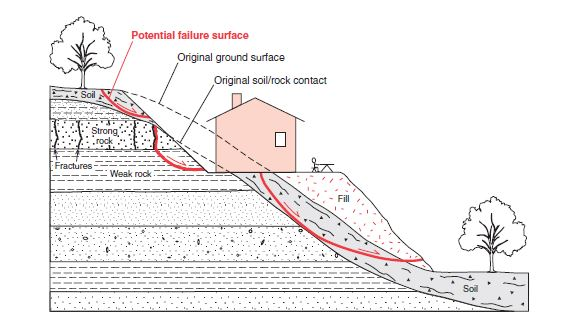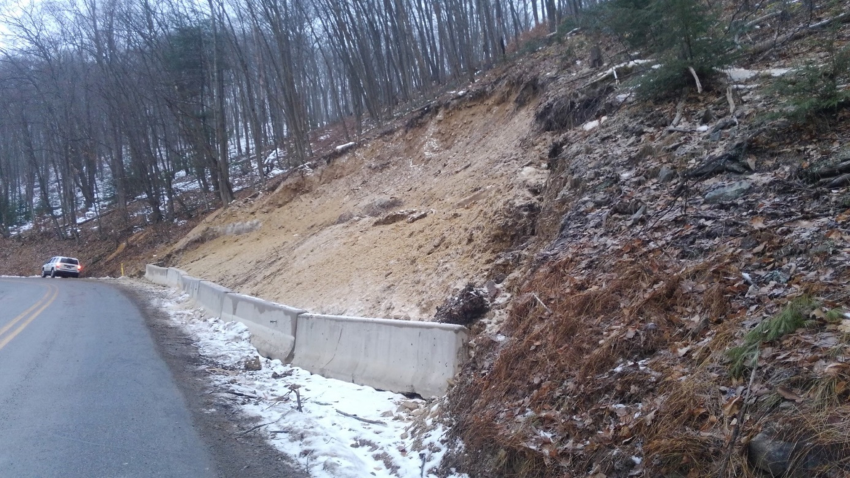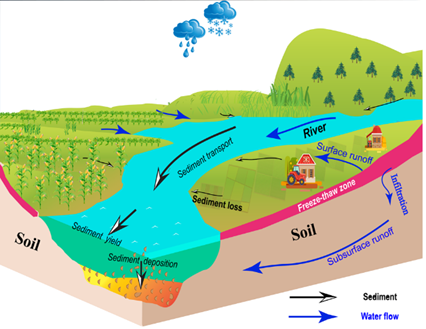World Soil Day is December 5th
Soils are the thin skin of the Earth, and the entire human race depends on soils every day of our lives, but have you ever stopped and considered the lasting impact developmental activities have on them?
Construction, Soils, and the Environment
During construction, especially new construction, soils are stripped, compacted, and/or replaced to ensure they can support the structure being placed upon them. This is great for the building, but not so much for the environment around the building.

Locations of potential slope failures created by surface disturbing activities associated with residential construction on a slope. Taken from Bureau of Geologic Survey’s Educational Series 09: Landslides.
Removing vegetation exposes the underlying soil directly to the elements. Increased water infiltration and runoff contribute to erosion because there is no vegetation to hold the soil in place on slopes. This runoff can cause streams to have an increased sediment load which can decrease visibility for aquatic life due to clouded waters, prevent vegetation growth, reduce water depth, and add higher levels of nutrients that cause toxic algae growth.
If the area is dry, bare soil contributes to dust generation. During periods of high winds this can create largescale dust storms, which can cause serious health risks to humans and animals. Dust is made up of small particles which can remain suspended in the air for days, lowering air quality and causing skin, eye, and ear irritation, as well as respiratory distress.
Landslides can occur from exposed soils on a slope. They can be caused by the additional water infiltrating the soil during rain events, too steep of a slope, and adding additional weight to soils in the form of buildings or other structures.

Soil slope failure, Wykoff Run Road, Quehanna Wild Area, Cameron County, PA. Photo taken Dec. 14, 2018 by Aaron Bierly, PA Bureau of Geological Survey.
How Geologists Contribute to Soil Conservation
Engineering geologists and geotechnical engineers work together to limit the amount of disturbance to soils, while still maintaining building integrity. They run computer models to ensure these slopes can and will remain stable after development. They also develop and ensure efforts are taken before, during, and after the construction process to stabilize slopes, prevent dust storms, and reduce runoff from the building site.
Resources like PaGEODE, developed by the Pennsylvania Geological Survey, and federal resources like USDA’s Web Soil Survey, are used to gather background information to assist in the computer models and development of methods to protect and preserve the soils at construction sites.

Soil erosion and deposition. Taken from Pronounced Increases in Future Soil Erosion and Sediment Deposition as Influenced by Freeze–Thaw Cycles in the Upper Mississippi River Basin.
How You Can Protect Soils During Construction
When starting a construction project on your property, such as installing a swimming pool or retaining wall, be aware of where the runoff containing soil particles lands. Make efforts to contain runoff with temporary sediment fences during construction. Plant vegetation as soon after construction as possible to anchor the soils. Even small efforts by individual property owners can help ensure that development activity has minimal impact on the greater environment.
Written By Stephanie Evans, Senior Geoscientist at the Pennsylvania Geological Survey
Image 1 Source- Delano, H. L., and Wilshusen, J. P., 2001, Landslides in Pennyslvania: Pennsylvania Geological Survey, 4th ser., Educational Series 9, 34 p.
Image 2 Source- Aaron Bierly, Pennsylvania Geological Survey
Image 3 Source- Wang, Q., Qi, J., Qiu, H., Li, J., Cole, J., Waldhoff, S., & Zhang, X. (2021). Pronounced increases in future soil erosion and sediment deposition as influenced by freeze–thaw cycles in the upper Mississippi River Basin. Environmental Science & Technology, 55(14), 9905–9915. https://doi.org/10.1021/acs.est.1c02692




